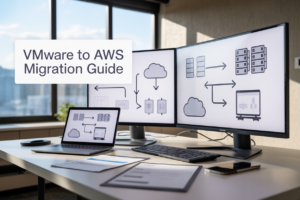Managing your AWS infrastructure efficiently can make or break your application’s performance and budget. EC2 scaling is the key to matching your server capacity with actual demand, but many developers struggle with choosing between manual, scheduled, and dynamic scaling strategies.
This guide is designed for cloud engineers, DevOps professionals, and developers who want to master AWS auto scaling and cloud performance optimization. Whether you’re running a small startup application or managing enterprise workloads, understanding the right scaling approach saves money and keeps your users happy.
We’ll break down EC2 scaling fundamentals so you understand when and why to scale, then dive into manual scaling techniques for hands-on control. You’ll also learn how scheduled scaling AWS solutions work perfectly for predictable traffic patterns, and discover dynamic scaling strategies that automatically respond to changing demand in real-time.
By the end, you’ll know exactly which AWS workload optimization strategy fits your specific needs and have practical EC2 best practices you can implement immediately.
Understanding EC2 Scaling Fundamentals
Core benefits of right-sizing your compute resources
Right-sizing your EC2 instances means matching your compute capacity exactly to your workload demands. When you nail this balance, you eliminate the waste of over-provisioned resources while avoiding the performance bottlenecks of under-provisioned infrastructure. Your applications run smoothly without paying for unused CPU cycles or memory that sits idle. This approach creates a foundation for responsive, cost-effective cloud operations that scale naturally with your business needs.
Cost savings through optimal resource allocation
EC2 scaling fundamentals directly impact your AWS bill through strategic resource allocation. Running oversized instances can triple your costs unnecessarily, while undersized resources force expensive emergency scaling. Smart scaling strategies reduce monthly expenses by 30-60% by automatically adjusting capacity based on actual usage patterns. You pay only for what you need when you need it, turning fixed infrastructure costs into variable expenses that align with revenue generation and business growth cycles.
Performance improvements with proper scaling strategies
Well-designed EC2 scaling policies eliminate performance degradation during traffic spikes and resource contention. Your applications maintain consistent response times whether serving 100 users or 10,000 users simultaneously. Proper scaling strategies prevent the dreaded slowdowns that drive customers away while ensuring resources are available before demand peaks hit. This proactive approach to cloud performance optimization keeps your services running at peak efficiency across varying workload conditions and user demands.
Manual Scaling Implementation and Best Practices
Step-by-step process for manual instance adjustments
Navigate to the AWS EC2 console and select your Auto Scaling group to adjust the desired capacity. Access the Details tab and click “Edit” to modify minimum, maximum, and desired instance counts. Monitor the Activity History tab to track scaling actions and verify new instances launch successfully. Update capacity gradually during low-traffic periods to minimize service disruption.
Monitoring metrics that trigger scaling decisions
CloudWatch provides essential metrics for EC2 manual scaling decisions. CPU utilization above 70% for 5+ minutes signals the need for additional instances, while consistently low usage below 30% indicates over-provisioning. Memory utilization, network I/O, and application-specific metrics like response times help determine optimal capacity. Set up custom alarms to receive notifications when thresholds are breached.
Time and resource considerations for manual management
Manual scaling requires dedicated personnel monitoring systems 24/7, especially during peak business hours and traffic spikes. Instance launch times typically range from 2-5 minutes, creating potential performance gaps during sudden demand increases. Budget additional costs for human resources and potential over-provisioning to maintain adequate response times. Plan scaling activities around predictable traffic patterns to reduce reactive adjustments.
Common pitfalls and how to avoid them
Avoid scaling too aggressively by implementing gradual capacity adjustments of 20-30% rather than doubling instances immediately. Don’t ignore warm-up periods – newly launched instances need 3-5 minutes to begin handling traffic effectively. Prevent cascading failures by maintaining minimum capacity buffers and testing scaling procedures during low-traffic periods. Document all scaling decisions and establish clear escalation procedures for emergency situations.
Scheduled Scaling for Predictable Workloads
Setting up time-based scaling policies
Configure scheduled scaling AWS policies by defining specific times when your EC2 instances should scale up or down. Create scaling schedules through the Auto Scaling console, specifying start times, end times, and desired capacity. Set recurring patterns for daily, weekly, or monthly cycles based on your application’s usage patterns. Define minimum and maximum instance limits to prevent over-provisioning while ensuring adequate resources during peak periods.
Maximizing cost efficiency during off-peak hours
Scale down EC2 instances during predictable low-traffic periods to reduce costs significantly. Schedule automatic capacity reduction during nights, weekends, or maintenance windows when user activity drops. Configure minimum instance counts to maintain essential services while eliminating unnecessary compute resources. Monitor CloudWatch metrics to validate that reduced capacity still meets performance requirements and adjust scheduling parameters accordingly for optimal cost savings.
Handling seasonal traffic patterns effectively
Plan EC2 scaling policies around seasonal demand fluctuations like holiday shopping spikes or back-to-school periods. Create multi-phase scaling schedules that gradually increase capacity weeks before expected traffic surges. Implement buffer scaling to handle unexpected demand variations within seasonal patterns. Use historical data to refine scaling timelines and capacity requirements, ensuring your infrastructure can handle both predictable seasonal loads and unexpected traffic variations efficiently.
Dynamic Scaling for Variable Demand
Auto Scaling Groups configuration for optimal performance
Auto Scaling Groups serve as the foundation for dynamic EC2 scaling, automatically launching and terminating instances based on demand. Configure launch templates with specific AMIs, instance types, and security groups to ensure consistent deployments. Set minimum, maximum, and desired capacity values that align with your application’s baseline and peak requirements. Distribute instances across multiple Availability Zones for high availability and implement health checks to replace unhealthy instances automatically. Define scaling cooldown periods to prevent rapid scaling oscillations and use instance warm-up times for applications requiring initialization.
CloudWatch metrics that drive intelligent scaling decisions
CloudWatch metrics provide the intelligence behind AWS auto scaling decisions, monitoring CPU utilization, memory usage, network throughput, and custom application metrics. Standard metrics like CPU utilization typically trigger scaling at 70-80% thresholds, while network metrics help identify I/O-bound workloads. Custom metrics allow scaling based on application-specific indicators like queue depth, active user sessions, or database connections. Set up composite alarms combining multiple metrics for more sophisticated scaling triggers. Monitor these metrics over appropriate time periods to avoid scaling on temporary spikes while maintaining responsiveness to genuine demand changes.
Target tracking policies for consistent application performance
Target tracking policies maintain specific performance targets by automatically adjusting capacity when metrics deviate from desired values. Set CPU utilization targets around 50-70% to maintain performance headroom while optimizing costs. Application Load Balancer request count per target helps scale based on actual user demand rather than just resource consumption. Database connection metrics ensure your data tier scales appropriately with application load. Configure scale-out and scale-in policies with different thresholds to prevent constant scaling churn. Target tracking offers simplicity compared to step scaling while providing predictable performance outcomes.
Step scaling strategies for rapid demand changes
Step scaling policies handle sudden traffic spikes by defining multiple scaling steps based on alarm breach magnitude. Create aggressive scaling rules for large metric deviations – add 50% capacity when CPU exceeds 80%, and 100% when it hits 90%. Design conservative scale-in policies to prevent over-reduction during temporary load decreases. Use different scaling steps for various time periods, scaling more aggressively during peak hours and conservatively during off-peak times. Implement multiple scaling policies targeting different metrics to handle diverse load patterns. Step scaling provides granular control over EC2 scaling policies while maintaining rapid response capabilities.
Predictive scaling for proactive resource management
Predictive scaling uses machine learning to forecast demand patterns and pre-scale resources before traffic arrives. This AWS auto scaling feature analyzes historical data to identify daily, weekly, and seasonal patterns in your workload. Enable predictive scaling for applications with regular traffic patterns like e-commerce sites with predictable daily peaks or batch processing jobs with scheduled runs. Configure forecast-only mode initially to validate predictions against actual demand before enabling automatic scaling. Combine predictive scaling with reactive policies for comprehensive cloud performance optimization, ensuring resources are available when needed while maintaining cost efficiency through intelligent capacity planning.
Choosing the Right Scaling Strategy for Your Workload
Workload analysis techniques for scaling decisions
Start by examining your application’s traffic patterns, CPU usage, and memory consumption over at least 30 days. Look for daily peaks, seasonal trends, and unexpected spikes that reveal when your application needs more resources. Monitor database connection pools, API response times, and error rates to understand how your workload behaves under different loads. Tools like CloudWatch metrics and custom application logs help identify whether your traffic follows predictable patterns or varies unpredictably. Document these patterns to determine if manual, scheduled, or dynamic scaling fits best. Consider your budget constraints and how quickly you need to respond to traffic changes, as this directly impacts which EC2 scaling strategy will work for your specific use case.
Hybrid approaches combining multiple scaling methods
Combine scheduled scaling with dynamic scaling for maximum efficiency and cost control. Set up scheduled scaling to handle predictable traffic patterns like daily business hours or weekly marketing campaigns, then add dynamic scaling policies to catch unexpected spikes. For example, schedule your instances to scale up before your morning rush and scale down after hours, while keeping dynamic policies active to handle sudden viral content or traffic surges. This AWS workload optimization approach reduces costs by avoiding over-provisioning while maintaining performance during unpredictable events. Use different scaling policies for different instance types, putting less critical services on scheduled scaling and mission-critical applications on dynamic scaling with faster response times.
Performance testing to validate scaling effectiveness
Run load tests that simulate real-world traffic patterns to verify your EC2 scaling policies work as expected. Create test scenarios that gradually increase load, sudden traffic spikes, and sustained high demand to see how quickly your instances respond. Measure key metrics like response time, error rates, and resource utilization during scaling events to identify bottlenecks or delays. Test your scaling policies during different times of day and days of the week to ensure they perform consistently. Monitor how long it takes for new instances to become healthy and start serving traffic, as this affects your application’s ability to handle sudden demand. Regular performance testing helps fine-tune your cloud scaling fundamentals and catch issues before they impact real users.
Getting the most out of your EC2 instances comes down to picking the right scaling approach for your specific needs. Manual scaling gives you complete control but requires hands-on management, while scheduled scaling works great when you can predict your traffic patterns. Dynamic scaling shines when dealing with unpredictable workloads that need real-time adjustments to handle sudden spikes or drops in demand.
The key is matching your scaling strategy to your workload characteristics and business requirements. Start by analyzing your traffic patterns, budget constraints, and team resources. Many successful deployments actually combine multiple approaches – using scheduled scaling for known busy periods and dynamic scaling as a safety net for unexpected changes. Take time to test different configurations in a staging environment before rolling out to production, and remember that the best scaling strategy is one that keeps your applications running smoothly while optimizing costs.




















